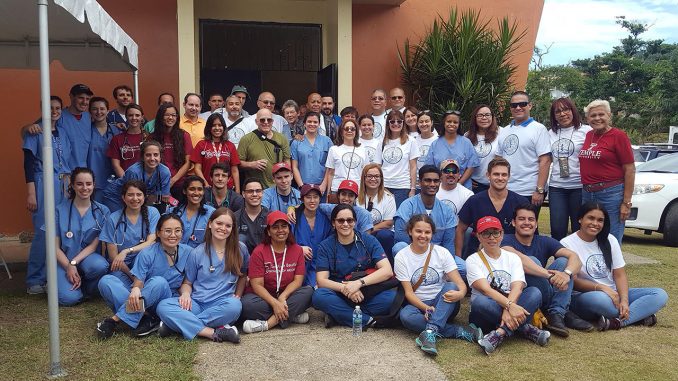
After hurricanes Irma and Maria hit Puerto Rico, Christina Lopez felt devastated. As a Puerto Rico native, Lopez was scared when she didn’t hear from her family living there for a week after the storm.
Driven by a passion for service and a call from her home, Lopez, a first-year medical student at the Lewis Katz School of Medicine, applied to be a student coordinator for Temple Emergency Action Corps.
This year, TEAC chose to send relief to Puerto Rico.
“I just always feel that I need to give back to my island,” Lopez said. “Everything that I heard said that my island was destroyed. I had food, I had water while my family was suffering, so it was natural to try to do something.”
TEAC is a student-led organization that assists in disaster relief on national and international levels. It was founded in 2005 at the medical school after Hurricane Katrina struck Louisiana, Alabama, the Bahamas and Cuba. Since then, the group has responded to disasters in Bolivia, Honduras, El Salvador and Haiti.
TEAC is led by student coordinators Lopez, Joe Corcoran and Jani Swiatek, who are all first-year medical students at Katz.
In 2017, Puerto Rico was hit by hurricanes Irma and Maria from late August to early October. Months later, the damage is still insurmountable. Sixteen percent of the island remains without power, according to a USA Today article from early March.
On Sunday, a group of 15 medical students and four doctors involved with TEAC concluded an eight-day disaster relief trip on the island.
“There’s still a lot of issues on the ground there, lack of fresh water and electricity, a lot of the Puerto Rican doctors have left and moved to the mainland and federal aid has been very lacking,” Corcoran said. “So Temple’s made a lot of efforts to improve that through the hospital and the medical school.”
During the week, the students worked in the small rural towns on the east side of the island, which was the region most devastated by both hurricanes according to the Federal Emergency Management Agency.
Over the course of their trip, the relief group treated an estimated 700 people.
The Puerto Rican island of Vieques needed the most care. The island’s hospital closed due to hurricane damage and the community has only been able to set up an emergency room under two tents with two general medical doctors, who alternate shifts.
The students brought more than basic medical care. They also provided food and water purification tablets because the country currently lacks access to clean water and has seen a spike in waterborne diseases.
TEAC and Puerto Rican doctors from the Ponce Health Sciences University came together to supply specialty doctors, including gynecologists, cardiologists, dermatologists and psychiatrists. They also had a pharmacy at each site where patients could receive medications.
Corcoran said the group set up clinics in each town they visited, and did not know the layout of each site until the day they arrived. One day the group worked outside in a courtyard. Another day, they worked inside a school building.
“When we pulled in in the morning, for me there was always about 10 minutes that was really fun, but also somewhat stressful,” Corcoran said. “I was thinking, ‘OK, how are we going to make this space work? And what physical barriers do we have in the space that we can use to our advantage?’”
Student coordinators faced some challenges, like a language barrier with patients. Some of the Puerto Rican medical students acted as translators to help bridge the gap.
Every time a natural disaster strikes a country, Corcoran said it takes years for a community to recover.
“The people who experience those events, they are still dealing with all of this every hour of every day, and so I think often that gets glossed over,” Corcoran said. “Short-term stuff is very good, but it’s important to continue thinking about ways to help with the recovery from things like this.”
Philadelphia doctors have also been providing aid to Puerto Rican evacuees. Dr. Manish Garg, an emergency medicine professor and faculty adviser for TEAC, has assisted many of the evacuees that come to Temple University Hospital.
“They will talk about the hurricane and in addition to their medical problems, they need good mental health care,” Garg said. “You can see the post-traumatic stress, you can see the anxiety, the depression, you know they’ve potentially lost loved ones. It’s very psychologically troubling.”
Last year ended with a 29 percent increase in suicide cases reported to Puerto Rico’s department of health, compared to 2016.
Garg believes it’s vital for Temple to act as a leader when disasters strike.
“It’s part of what I understand as the mission of Temple,” Garg said. “Temple is a beacon of hope for patients. We serve as a place where people can get healthcare in a non-judgemental way.”
For medical students like Lopez, TEAC provides important hands-on experiences.
“This experience opened my eyes to how we can both go as a foreigner and help out the community, and also work with all of the locals and provide something that’s long-lasting,” Lopez said.


Be the first to comment